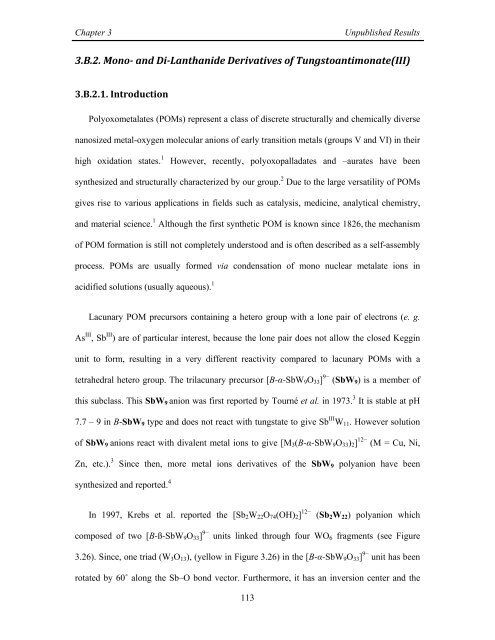Synthesis and Structural Characterization of ... - Jacobs University
Synthesis and Structural Characterization of ... - Jacobs University
Synthesis and Structural Characterization of ... - Jacobs University
You also want an ePaper? Increase the reach of your titles
YUMPU automatically turns print PDFs into web optimized ePapers that Google loves.
Chapter 3<br />
Unpublished Results<br />
3.B.2. Mono‐ <strong>and</strong> Di‐Lanthanide Derivatives <strong>of</strong> Tungstoantimonate(III)<br />
3.B.2.1. Introduction<br />
Polyoxometalates (POMs) represent a class <strong>of</strong> discrete structurally <strong>and</strong> chemically diverse<br />
nanosized metal-oxygen molecular anions <strong>of</strong> early transition metals (groups V <strong>and</strong> VI) in their<br />
high oxidation states. 1<br />
However, recently, polyoxopalladates <strong>and</strong> –aurates have been<br />
synthesized <strong>and</strong> structurally characterized by our group. 2 Due to the large versatility <strong>of</strong> POMs<br />
gives rise to various applications in fields such as catalysis, medicine, analytical chemistry,<br />
<strong>and</strong> material science. 1 Although the first synthetic POM is known since 1826, the mechanism<br />
<strong>of</strong> POM formation is still not completely understood <strong>and</strong> is <strong>of</strong>ten described as a self-assembly<br />
process. POMs are usually formed via condensation <strong>of</strong> mono nuclear metalate ions in<br />
acidified solutions (usually aqueous). 1<br />
Lacunary POM precursors containing a hetero group with a lone pair <strong>of</strong> electrons (e. g.<br />
As III , Sb III ) are <strong>of</strong> particular interest, because the lone pair does not allow the closed Keggin<br />
unit to form, resulting in a very different reactivity compared to lacunary POMs with a<br />
tetrahedral hetero group. The trilacunary precursor [B-α-SbW 9 O 33 ] 9− (SbW 9 ) is a member <strong>of</strong><br />
this subclass. This SbW 9 anion was first reported by Tourné et al. in 1973. 3 It is stable at pH<br />
7.7 – 9 in B-SbW 9 type <strong>and</strong> does not react with tungstate to give Sb III W 11 . However solution<br />
<strong>of</strong> SbW 9 anions react with divalent metal ions to give [M 3 (B-α-SbW 9 O 33 ) 2 ] 12− (M = Cu, Ni,<br />
Zn, etc.). 3<br />
Since then, more metal ions derivatives <strong>of</strong> the SbW 9 polyanion have been<br />
synthesized <strong>and</strong> reported. 4<br />
In 1997, Krebs et al. reported the [Sb 2 W 22 O 74 (OH) 2 ] 12−<br />
(Sb 2 W 22 ) polyanion which<br />
composed <strong>of</strong> two [B-ß-SbW 9 O 33 ] 9− units linked through four WO 6 fragments (see Figure<br />
3.26). Since, one triad (W 3 O 13 ), (yellow in Figure 3.26) in the [B-α-SbW 9 O 33 ] 9− unit has been<br />
rotated by 60˚ along the Sb–O bond vector. Furthermore, it has an inversion center <strong>and</strong> the<br />
113

















